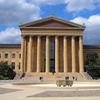More about Unicorns Came Down to the Sea

Contributor
Unicorns Came Down to the Sea by Kay Sage is so perfect that it could almost be a sculpture rather than a painting.
This piece was painted during the most productive period of Sage’s life, which just happened to be between the time she married Yves Tanguy in 1940 and his death in 1955. Coincidence? Sage would never say so, but no. The couple was living on a farm in Woodbury, Connecticut and maintained his and her studios. They were hanging out with French expats and American artists like Alexander Calder and having a grand old time. But this painting marked the beginning of the last decade that Sage would ever paint with oil again. Duhn duhn duhhhhhnn. After Tanguy’s death, she lost her artistic drive due to a particularly awful combination of deep depression and semi-blinding cataracts.
When asked what her philosophy of art is, Sage replied, “Have never made any statement except to say that were I able to give any explanations, I would probably not paint. Have no other comment to make.” So since Sage is less than helpful, we’ll have to go out on a limb and guess what this piece is about. We know that she considered herself a Surrealist even though André Breton, the founder of the movement, hated her and talked sh*t on her to Tanguy any chance he got. And by the incredible detail and perfection in composition of this piece, Breton’s objections to her participation in the group were exclusively based on the fact that she stole his best friend away from him. “Sage was a slow, meticulous painter. She used a tight line, defined the hard edges of her geometric designs with exacting care, and built up a seamless paint surface. The haunting, dreamlike atmosphere of her paintings arises in large part from a flawless rendering of objects one cannot quite name and scenes one cannot quite place, that seem suspended in midair.” This was something new and different for the Surrealist movement, which only made Breton look dumber for not accepting Sage into the group.
And as for the title we don't know where the unicorns or the sea are in this piece. It seems like she is just trying to confuse her viewers with that one. If only she could see people assessing her works in museums now, discussing haughtily the metaphorical use of the unicorn and its ramifications amongst the dismal and apocalyptic architecture of surrealism. *pushes reading glasses up, sips obscure spirit, and chuckles with head tilted back*
Sources
- Barone, Joshua. "Focusing On Women In Surrealism." Nytimes.com. N.p., 2015. Web. 3 Apr. 2018.
- Blumberg, Naomi, and Sonia Chakrabarty. "Kay Sage | American Painter And Poet." Encyclopedia Britannica. N.p., 2015. Web. 3 Apr. 2018.
- Chadwick, Whitney, and Isabelle De Courtivron. Significant Others : Creativity & Intimate Partnership. New York: Thames and Hudson, 1993. Web. 3 April. 2018.
- O'Doherty, Brian. "Art: Wry Constructions; Kay Sage Arranges Simple Objects In Surrealist Environment For Effect." Timesmachine.nytimes.com. N.p., 1961. Web. 3 Apr. 2018.
- Suther, Judith D. A House of Her Own: Kay Sage, Solitary Surrealist. Lincoln: University of Nebraska Press, 1997, p.1
- "Unicorns Came Down To The Sea." Philadelphia Museum of Art. Web. 3 Apr. 2018.











